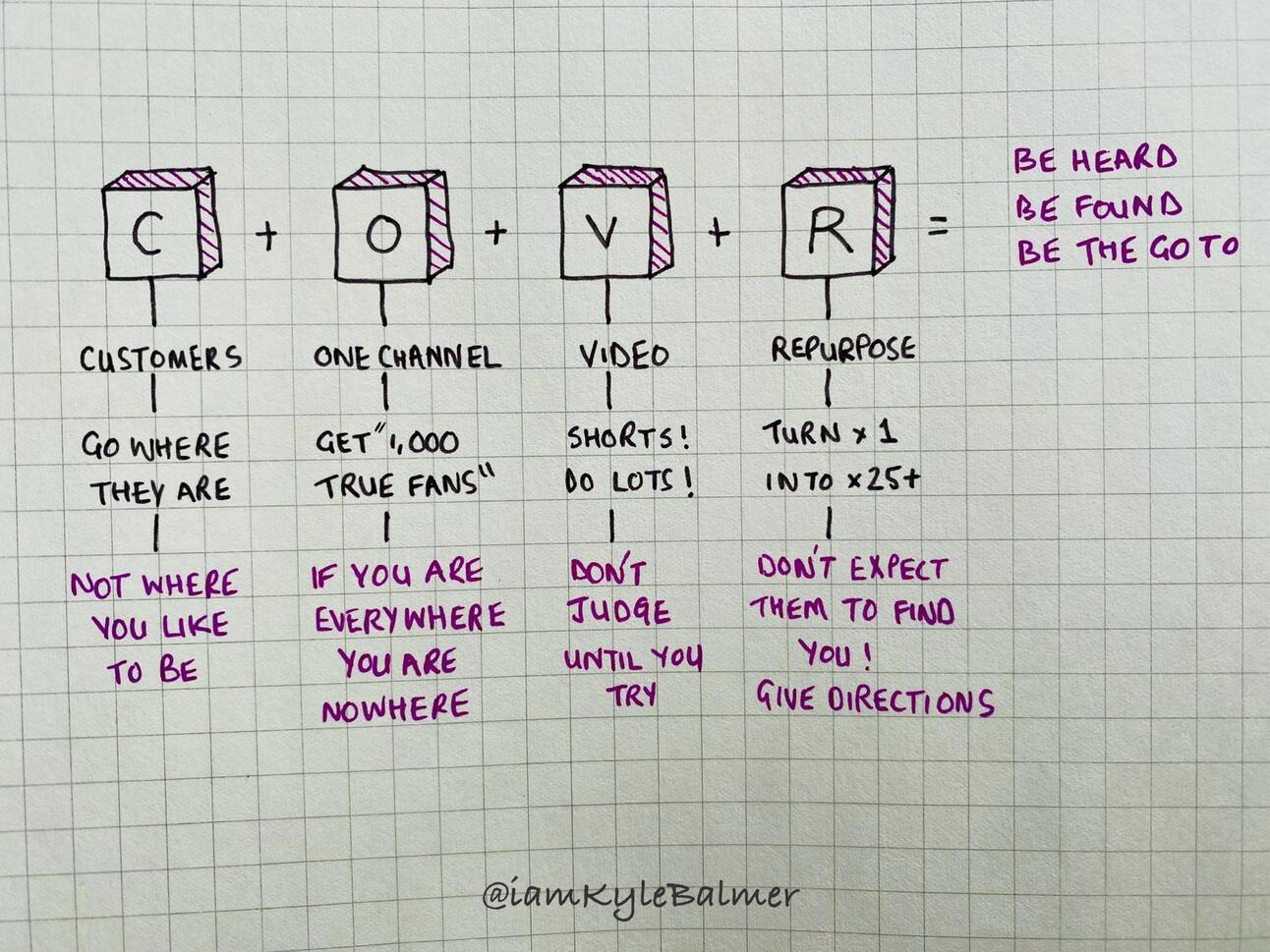Introduction
Now that you have your brand basics lined up it’s time to start getting the word out.
In my BATON model (Business, Audience, Tribe, Offer, Network) this is the core of Audience – taking your message and making sure your potential customers hear it.
It’s a big topic so we’ll cover the core fundamentals today.
We’ll get rolling right after this word from our sponsor.

The Rundown is the world’s fastest-growing AI newsletter, with over 500,000+ readers staying up-to-date with the latest AI news and learning how to apply it.
Our research team spends all day learning what’s new in AI, then distills the most important developments into one free email every morning.
Let’s get started:
Project and be heard
Building an Audience is a massive topic obviously – I’ve written maybe 10 Prompt Playbooks on the area already.
Today we’ll cut it down to my top recommendations.
We’ll follow COVR: Customers, One focus, Video, Repurposing.

Yes, there should be an E, I know I know.
But I’m not going to stick in something random just for the tidy acronym. I respect you too much for that 😗
Customers
Here’s a biggie. You need to be putting your brand out in front of your customers.
Not only your peers.
Just because other people in your industry are on a particular channel (say, LinkedIn or Twitter) this doesn’t mean it’s where you need to build your brand.
We want to be putting our content, and thus our brand, in front of customers. So make sure you know where they are.
It’s a subtle distinction but important.
For example I use Twitter/X to build my reputation, make connection with peers and be an authority.
But that’s not where my customers are. My individual customers are on Facebook and TikTok. My corporate customers are on LinkedIn.
Obviously building your professional reputation amongst peers is very useful. But it’s not the primary focus – we are focusing right now on customers and revenue.
How do you find where your customers are? Lots of ways but my favourite (because it is fast!) is running adverts.
Direct advertising instantly turns on the traffic tap and tells you immediately how people will react to your content and your brand.
It’s much cheaper (in the long run!) than spending lots of time trying to build an organic following.
For example I ran ads for this newsletter on 6 different channels to see what would work best.
For me I found it was Facebook, a channel I personally don’t use or enjoy but it turns our my audience and customers hang out on. What I want has nothing to do with it! It’s where my customers are.
One focus
Once you’ve found your channel go hard on that ONE channel.
Don’t spread your effort yet but instead build an organic following on one channel.
This lets you refine your message and get in the reps required.
If you immediately try to be everything, everywhere all at once (great film) you’ll fail.
Yes you can get cool tools that post everywhere.
But you also need to be present there to engage. And that takes time. You cannot just push out content and hope to build a following without also engaging.
So once you know the one channel where your customers hang out double down on that.
Your first benchmark is 1,000 followers. Once you get to that you can look at other channels. Until then stay focused.
Video
If you’ve spent anytime with me (hi) you probably knew this was coming.
Right now you need to be doing video.
More than that: short video.
It’s simply the fastest, easiest way to get your brand out there.
The benefits include you being able to be authentically yourself and speed/low cost of production.
More importantly (and cynically) it’s what the channels want. All of the main social platforms want short video.
And they want it because it is what their audiences want. Makes sense.
Regardless of what you think about short video it’s the format that audiences want and thus the channels want.
Hell, you probably enjoy short video yourself. Why wouldn’t everyone else? Keep it simple by sticking to what works. It increases your chances of success.
Repurposing
Finally, once we have found our one channel and once we are happy producing video we can look at the most powerful tool at our disposal.
Repurposing.
Repurposing is basically taking one piece of content and making it suitable for other channels.
For example a blog article can be sliced and diced into short social media posts. That’s repurposing.
If we start with video we have the most information dense format.
Video has image and audio. And if you have audio you have text. It’s a three for one (threefer?), containing all the major media types.
I’ve written a whole Prompt Playbook exclusively on repurposing so won’t retread. The main takeaway is that repurposing is the key to hitting the other channels.
This is the point where we can expand and start getting more traffic from more channels. Via the mechanism of repurposing.
COVR up
We started with one primary channel based on it being where our customers are.
We focus entirely on this one channel until we find our feet and are confident in our branding and messaging.
We use video because it’s the single most powerful single format. It gives us the best chance to grow our brand by swimming with the current rather than against it.
We then deploy repurposing in order to multiply our impact over other channels. But only once we have the other elements aligned.